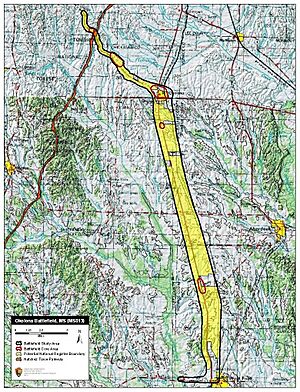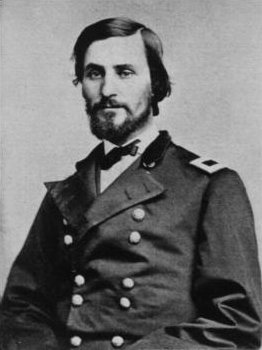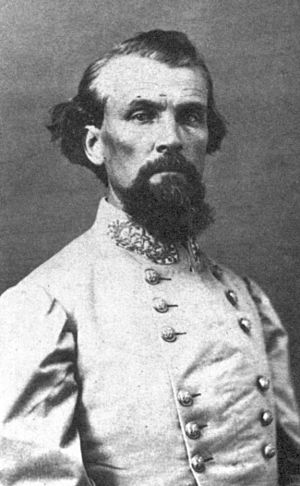Battle of Okolona facts for kids
Quick facts for kids Battle of Okolona |
|||||||
|---|---|---|---|---|---|---|---|
| Part of the American Civil War | |||||||
|
|||||||
| Belligerents | |||||||
| Commanders and leaders | |||||||
| William Sooy Smith | Nathan Bedford Forrest | ||||||
| Units involved | |||||||
| Meridian Mississippi Expedition Cavalry | Forrest's Cavalry Corps | ||||||
| Strength | |||||||
| 7,000 | 2,500 | ||||||
| Casualties and losses | |||||||
| 388 | 144 | ||||||
The Battle of Okolona happened on February 22, 1864, in Chickasaw County, Mississippi. It was a fight between soldiers from the Confederate side and the Union side during the American Civil War.
Confederate cavalry, led by Major General Nathan Bedford Forrest, faced a much larger Union cavalry force of over 7,000 soldiers. These Union soldiers were under the command of Brigadier General William Sooy Smith. The Confederates won the battle near Okolona. The Union lost 100 soldiers, while the Confederates lost 50.
General Smith's Union force was supposed to leave Memphis, Tennessee, and meet up with a larger Union army. This main army, with 20,000 soldiers, was marching towards Meridian, Mississippi, led by Major General William Tecumseh Sherman. However, Smith didn't follow his orders. He waited ten days for another unit that was stuck because of ice in Kentucky.
When Smith finally started his march, he met the Confederate cavalry on February 21. On February 22, he fought a long battle over eleven miles against Forrest's soldiers. With more Confederate soldiers arriving, Forrest defeated Smith's troops. Forrest couldn't chase them far because he didn't have enough ammunition. Smith's tired army crossed into Tennessee on February 26. He was later criticized for putting General Sherman's plan, called the Meridian Expedition, in danger.
Why the Battle Happened
Meridian was a very important railroad hub during the war. It was the target of a big military plan started by General Sherman on February 3. Sherman left Vicksburg, Mississippi, with 20,000 soldiers and reached the edge of Meridian.
General Smith's 7,000 cavalry soldiers were in Memphis. On February 1, they were ordered to go to Meridian along the Mobile & Ohio Railroad. They were supposed to meet Sherman's main force by February 10.
While Sherman marched towards Meridian, trying to trick Confederate forces, Smith delayed his own advance for 10 days. He finally left on February 11. His soldiers moved through the countryside without much trouble. They destroyed railroads and crops. They also helped about 1,000 enslaved people gain freedom.
On February 16, Smith passed through New Albany. His progress was slow because the roads were very muddy. On February 18, he pushed a Confederate force out of West Point. By February 20, he was 90 miles from Meridian, just outside West Point. At this time, Sherman had already left Meridian and gone back to Vicksburg because he was worried about Smith. When Smith heard this, he turned around and headed towards Okolona.
Later on February 20, Smith had a small fight with Confederate soldiers led by Forrest near Prairie Station and Aberdeen. On February 21, Smith decided to go back to West Point. He was worried about how many Confederate soldiers there were and what would happen to the enslaved people if they were captured. A Confederate cavalry group, led by Colonel Jeffrey Forrest (General Forrest's younger brother), tricked Smith into a swampy area near the Tombigbee River. Smith had to retreat again, leaving a small group of soldiers to protect his main force. This group followed two hours later.
The Main Fight
General Forrest arrived as the last Union soldiers were retreating. He led the first attack at dawn on February 22, in the open field south of Okolona. The Union soldiers had gotten off their horses and built barricades to protect themselves.
Forrest started a direct attack and also tried to attack from the sides. With more Confederate soldiers joining, they broke through the Union lines. This made the Union soldiers retreat quickly, leaving behind five cannons.
The Union soldiers regrouped on a ridge. During the intense fighting, Colonel Forrest, the major general's younger brother, was killed by a shot to the neck. It is said he died in his brother's arms. The Confederate attack slowed down after this sad event. But the older General Forrest quickly brought new energy to the fight. He led a charge to "get revenge" and break the Union positions. During the chase, Forrest and his group were briefly surrounded. But then Colonel McCullough arrived with more soldiers to help.
The Union soldiers began an eleven-mile running battle as they pulled back. They tried to set up defenses at plantations and roadblocks. But these positions were quickly given up when the Confederates attacked. Towards the end of the day, the Union soldiers formed three lines in a field. They charged the Confederates, who fired their guns together, stopping both charges from about 40 yards away. Facing such a defeat, Smith began to retreat even further.
General Forrest quickly ordered his soldiers to stop chasing because they were running out of ammunition. But Smith still had to deal with other Mississippi militia groups during the rest of his retreat to the Tennessee border.
At Collierville, Tennessee, Smith crossed into Tennessee on February 26 with the rest of his soldiers. There, he was criticized for not following his original orders to start for Meridian on February 1. Because of his declining health, Smith left the military in September 1864 and went back to his normal life.
Saving the Battlefield
The Civil War Trust (which is now part of the American Battlefield Trust) and its partners have bought and protected about 77 acres (0.31 km2) of the Okolona battlefield. This helps save this important historical site.




